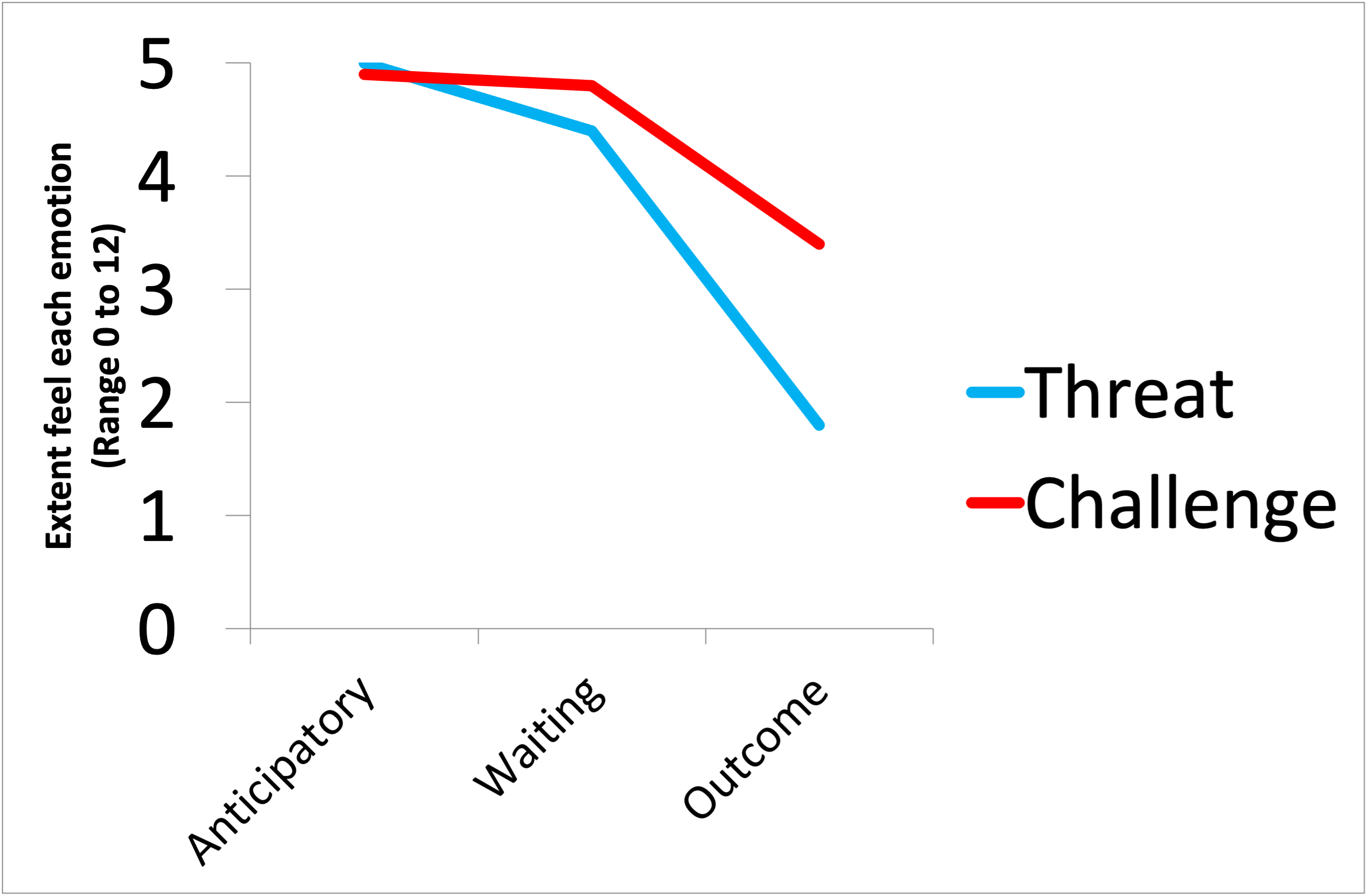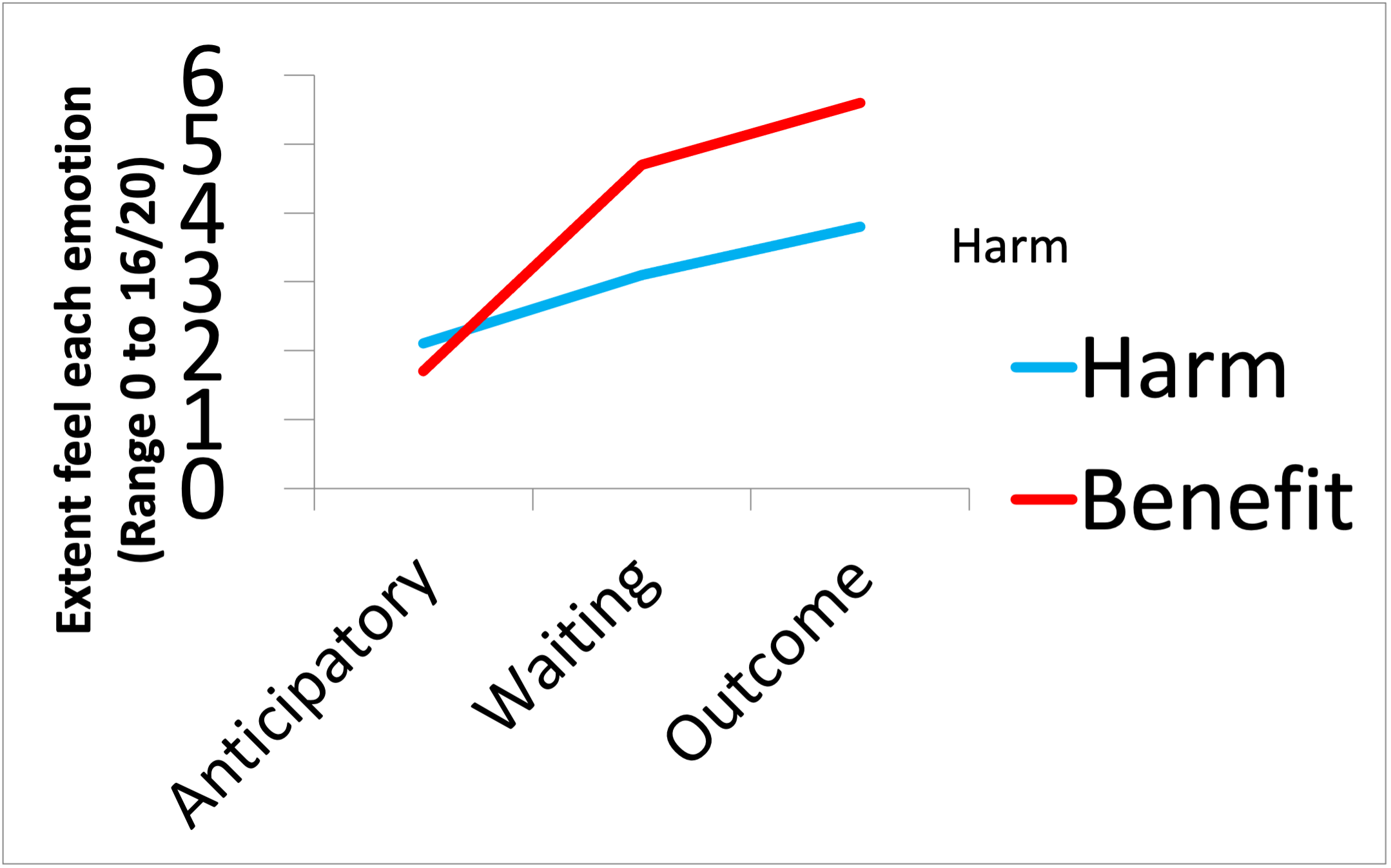Lazarus views stress as a process during which our interpretation of the event causes changes in our emotions. In a classic study, Folkman and Lazarus (1985) assessed undergraduate students’ emotions at three time periods of a mid-term exam (see Table 10 below). During the anticipatory stage, students are preparing for the exam, but the actual exam is ambiguous – students do not know the difficulty or questions on the exam. The waiting stage occurs after students complete the exam and are waiting for the outcome – their grade! At this point, students should have a better idea about their exam performance compared to when they were in the anticipatory stage. The outcome stage is when students learn about their grade. Because Lazarus views stress as an unfolding process of emotions, he suggests that our emotions in each stage should be different because we will have different cognitive appraisals in each stage.
Table 10
Stages of Stress based on Folkman and Lazarus (1985)
A table with 3 different stages and information about them
| Stage |
Stage Type |
When stage occurs |
| T1 |
Anticipatory Stage |
2 Days before mid-term |
| T2 |
Waiting Stage |
5 days after mid-term |
| T3 |
Outcome Stage |
2 Days after grades announced |
During each of the stages, participants reported the extent to which they felt 15 different positive and negative emotions. Folkman and Lazarus hypothesized that the emotions participants reported would depend on whether they made one of four cognitive appraisals. Table 11 displays the four cognitive appraisals, their definitions, corresponding emotions, and the scale range on which participants rated each group of emotions. Each appraisal causes these emotions. Threat and challenge appraisals are called anticipatory appraisals because people are predicting or anticipating the outcome of an upcoming stressor. Harm and benefit appraisals are called outcome appraisals because the emotions are elicited based on whether the outcome was perceived as good or bad.
Table 11
Definitions of Stress Appraisals from Folkman and Lazarus (1985)
A table of Stress appraisal definitions
| Appraisal |
Definition |
Emotion |
Range of Scale Responses |
| Threat |
Appraise the situation and determine we DO NOT possess the resources needed to successfully overcome the stressor. |
Worried, fearful, anxious |
0-12 |
| Challenge |
Appraise the situation and determine we DO have the appropriate resources to successfully overcome the stressor. |
Confident, hopeful, eager |
0-12 |
| Harm |
Appraise the situation and we PERCEIVE the outcome was negative |
Angry, sad, disappointed, guilty, disgusted |
0-20 |
| Benefit |
Appraise the situation and we PERCEIVE the outcome was positive. |
Exhilarated, pleased, happy, relieved |
0-16 |
Figure 23 shows how threat and challenge emotions changed across the three stages, while Figure 24 shows how harm and benefit emotions changed. Results showed that students reported the highest levels of threat and challenge emotions in the anticipatory stage – when they were evaluating whether they have the resources to deal with the upcoming event. In the outcome stage, threat and challenge emotions have significantly decreased from the anticipatory stage. Why? Well in the outcome stage participants now know their grade and they are no longer anticipating the outcome of the midterm. In the anticipatory stage, 94% of students reported the simultaneous experience of challenge and threat emotions – which suggests that during the anticipatory stage people experience mixed positive and negative emotions! Why would this be? Well in the anticipatory stage people perceive that either a good or bad outcome could occur.
Figure 23
Threat and Challenge Emotions across Three Stages

Adapted from “If it changes it must be a process: Study of emotion and coping during three stages of a college examination,” by S. Folkman and R.S. Lazarus, 1985, Journal of Personality and Social Psychology, 48(1), p. 155 (If it changes it must be a process: Study of emotion and coping during three stages of a college examination.). Copyright 1985 by the American Psychological Association.
Long Description
The image is a line graph depicting the extent of emotional experience ranging from 0 to 12. The y-axis represents the extent to which each emotion is felt, while the x-axis is labeled with three stages: Anticipatory, Waiting, and Outcome. There are two lines on the graph: a blue line representing “Threat” and a red line representing “Challenge.” Both lines start at approximately the same level in the Anticipatory stage, with values around 5. As the stages progress from Anticipatory to Waiting and finally to Outcome, both lines decline. The blue “Threat” line decreases more steeply compared to the red “Challenge” line, indicating different emotional shifts through the stages.
Figure 24 below shows how harm and benefit emotions change over time. Harm and benefit emotions were lowest in the anticipatory stage, increased in the waiting stage, and further increased in the outcome stage. Harm and benefit emotions change over time because at each stage students receive more information about the outcome of the midterm exam – as their appraisals change, their emotions change. These findings show that during the outcome stage, students experienced either harm OR benefit emotions. In fact, harm and benefit emotions were negatively correlated. Remember, harm and benefit emotions are based on people’s perceptions of the outcome. So, people who perceived their midterm exam was good – felt benefit emotions, while people who perceived their midterm grade was bad – felt harm emotions. This means that for some students, a B on the exam would cause harm emotions and for other students a B would cause benefit emotions.
Figure 24
Harm and Benefit Emotions across Three Stages

Adapted from “If it changes it must be a process: Study of emotion and coping during three stages of a college examination,” by S. Folkman and R.S. Lazarus, 1985, Journal of Personality and Social Psychology, 48(1), p. 155 (If it changes it must be a process: Study of emotion and coping during three stages of a college examination.). Copyright 1985 by the American Psychological Association.
Long Description
The image is a line graph depicting the extent to which emotions are felt across three stages: Anticipatory, Waiting, and Outcome. The x-axis represents these stages, while the y-axis, labeled “Extent feel each emotion (Range 0 to 16/20)”, represents the emotional intensity. Two lines are plotted: a blue line labeled “Harm” and a red line labeled “Benefit”. The “Harm” line starts lower and progresses steadily, while the “Benefit” line begins slightly higher and rises sharply, ending notably higher than the “Harm” line at the Outcome stage. The labels for the axes are oriented vertically on the y-axis and diagonally on the x-axis.
One last thing to consider are the emotions that occurred during the waiting stage. By comparing the two figures above, one could conclude that during the waiting stage students felt all four groups of emotions. This is because they have more information about the difficulty of the exam, so they could start to engage in harm and benefit appraisals. But they still do not know their grade and are still anticipating their grade (maybe the professor will curve!) – so they still show challenge and threat emotions too!



